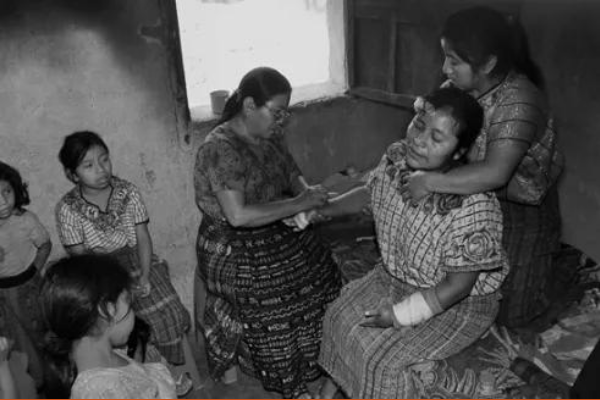Los hueseros (Bonesetters)
The main task of a huesero (known as “ajk'ax baak” in Maya) is to fix bone and ligament issues by setting them back in place. Many hueseros learn their craft primarily through hands-on practice from family members or more experienced healers in the community, but prior to beginning their learning, practitioners must experience a divine call, often in the form of a dream. Tradition dictates that simply going into bone setting half-heartedly, or on the other hand, ignoring a supernatural experience calling one forward to study, will only reap bad luck and possibly even an early death. There is unfortunately no divine remedy for setting a bone in a painless manner, however, as you will see depicted in the artwork below.
Traditional art depicting a huesero (bonesetter) by Salvador Reanda Quieju
When interviewed about the ways in which they experienced their initial divine callings, hueseros reported everything from hallucinations of bones appearing while working in a maize field to multiple repetitive dreams. These dreams can include scenarios such as bones asking to be picked up, characters in a dream teaching the individual songs which contain healing instructions, or testing an individual on how to put a skeleton together. One commonality a lot of hueseros share is that early on in their learning of how to set bones, they find a small bone and tuck it away in their clothing or a designated pouch, making sure they have it on them when they’re working. This bone is not exactly a tool used to treat patients, it’s more like a form of accreditation. However, it’s still considered to be a sacred object that transmits supernatural healing knowledge, and will usually be buried alongside the huesero.
Practicing hueseros don’t usually charge a set fee and instead rely on whatever is in the means of a patient or their family. If they’re asked to attend to a patient far away from their home, their room, board and transportation is usually covered, however studies have shown that pride in helping someone achieve well-being and putting one’s own divine gifts to use is a strong intrinsic motivating factor for many practitioners, in and of itself.
Traditional bonesetting session. Photo by Fran Antmann
Some hueseros work mainly independently, while others are grouped into larger committees or work out of health centers. For examples, in the city of Holpechén (Campeche state), there is a health center which offers services in midwifery, bonesetting and herbal medicine and also houses an on-site pharmacy and garden. In the city of Felipe Carrillo Puerto in Quintana Roo (where Na’atik is happily located), there are local hueseros in the city as well as in the Maya communities. One of them is located just a few blocks down from Na’atik.
Want to get more serious about learning the Maya language and culture? Our professionally certified native-speaking Maya teachers from Mexico can get you to speak the language from day one! Connect with us at say@naatikmexico.org to inquire and book a package.
More information can be found here


